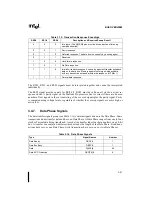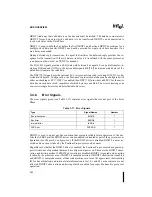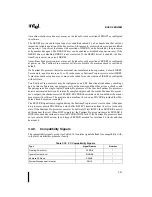
3-10
BUS OVERVIEW
The Pentium Pro processor converts non-cacheable misaligned memory accesses that cross 8-
byte boundaries into two partial transfers. For example, a non-cacheable, misaligned 8-byte read
requires two Read Data Partial transactions. Similarly, the Pentium Pro processor converts I/O
write accesses that cross 4-byte boundaries into 2 partial transfers. I/O reads are treated the same
as memory reads.
On the Pentium Pro processor, I/O Read and I/O Write transactions are 1 to 4 byte partial trans-
actions.
3.4.
SIGNAL OVERVIEW
This section describes the function of the Pentium Pro processor bus signals. In this section, the
signals are grouped according to function.
In many cases, signals are mapped one-to-one to physical pins with the same names. In other
cases, different signals are mapped onto the same pin. For example, this is the case with the ad-
dress pins A[35:3]#. During the first clock of the Request Phase, the address signals are driven.
The first clock is indicated by the lower case a, or just the pin name itself: Aa[35:3]#, or
A[35:3]#. During the second clock of the Request Phase, other information is driven on the re-
quest pins. These signals are referenced either by their functional signal names DID[7:0]#, or by
using a lower case b with the pin name: Ab[23:16]#. Note that several pins also have configu-
ration functions at the active to inactive transition of RESET#.
3.4.1.
Execution Control Signals
The BCLK (Bus Clock) input signal is the Pentium Pro processor bus clock. All agents drive
their outputs and latch their inputs on the BCLK rising edge. Each Pentium Pro processor de-
rives its internal clock from BCLK by multiplying the BCLK frequency by a multiplier deter-
mined at configuration. See Chapter 9, Configuration for configuration specifications.
The RESET# input signal resets all Pentium Pro processor bus agents to known states and in-
validates their internal caches. Modified or dirty cache lines are NOT written back. After RE-
SET# is deasserted, each Pentium Pro processor begins execution at the power on reset vector
defined during configuration. On observing active RESET#, all bus agents must deassert their
outputs within two clocks. Configuration parameters are sampled on the clock following the
sampling of RESET# inactive. (Two clocks following the deassertion of RESET#.)
Table 3-2. Execution Control Signals
Pin/Signal Name
Pin/Signal Mnemonic
Number
Bus Clock
BCLK
1
Initialization
INIT#, RESET#
2
Flush
FLUSH#
1
Stop Clock
STPCLK#
1
Interprocessor Communication and Interrupts
PICCLK, PICD[1:0]#, LINT[1:0]
5
Summary of Contents for Pentium Pro Family
Page 17: ...1 Component Introduction ...
Page 26: ...2 Pentium Pro Processor Architecture Overview ...
Page 27: ......
Page 36: ...3 Bus Overview ...
Page 62: ...4 Bus Protocol ...
Page 105: ...5 Bus Transactions and Operations ...
Page 126: ...6 Range Registers ...
Page 131: ...7 Cache Protocol ...
Page 135: ...8 Data Integrity ...
Page 148: ...9 Configuration ...
Page 161: ...10 Pentium Pro Processor Test Access Port TAP ...
Page 172: ...11 Electrical Specifications ...
Page 201: ...12 GTL Interface Specification ...
Page 229: ...13 3 3V Tolerant Signal Quality Specifications ...
Page 233: ...14 Thermal Specifications ...
Page 239: ...15 Mechanical Specifications ...
Page 241: ...15 2 MECHANICAL SPECIFICATIONS s Figure 15 1 Package Dimensions Bottom View ...
Page 252: ...16 Tools ...
Page 260: ...16 8 TOOLS Figure 16 4 Generic MP System Layout for Debug Port Connection ...
Page 264: ...17 OverDrive Processor Socket Specification ...
Page 290: ...A Signals Reference ...
Page 320: ...Index ...
Page 328: ......















































